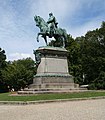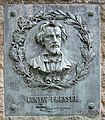Gustav Eberlein
Gustav Heinrich Eberlein (born July 14, 1847 in Spiekershausen , † February 5, 1926 in Berlin ) was a German sculptor , painter and writer . Around 1900, after Reinhold Begas, he was the busiest artist at the Berlin sculpture school of the 19th century.
Life

Eberlein was born as the son of the tax inspector Johannes Josephus Eberlein and Margarethe Elisabeth. Born in Spiekershausen near Kassel. At the age of 8, he moved to Hannoversch Münden with his parents and sister Catharina Sophie Luise . This city became his hometown, to which he remained lifelong. A bronze relief with his portrait is attached to his childhood home (see photo on the left). Since the parents didn't have the money to study art for their son, he ultimately learned the goldsmith's trade after various other apprenticeships. From 1866 he attended the art school in Nuremberg, from 1869 he received a scholarship in Berlin.
Politically, Eberlein emerged around 1900 through his engagement against the Lex Heinze and his commitment to peace between France and Prussia. Due to his critical attitude and his disapproved reference to works by Auguste Rodin and Constantin Meunier , 16 of 20 works were removed from the Great Berlin Art Exhibition in 1900 "on the highest instructions".
Eberlein’s grave in the Old St. Matthew Cemetery was designated as an honorary grave for the city of Berlin from 1990 to 2014 . Since November 2018 it has been a grave of honor again.
family
He married Helene von Frankenberg and Ludwigsdorf (born April 7, 1853) in 1873 . The couple had a son Anzio (* 1878), who died in 1881. The marriage ended in divorce in 1891. Eberlein married Marie von Hertzberg (* 1862), a daughter of the Prussian Major General Julius von Hertzberg , on December 24, 1893 , and this marriage was divorced again.
plant
Eberlein was particularly successful in the field of portrait and small sculpture. A total of over 900 works of sculpture, painting and writing are known. The catalog raisonné contains over 600 illustrations. Many museums in Germany and abroad have works by Eberlein, including the Alte Nationalgalerie in Berlin (including Dornauszieher ).
His work includes the Goethe monument in Rome, the Richard Wagner monument and the Lortzing monument in Berlin's Tiergarten , and the monumental work “God the Father breathes Adam into his breath” in Hann. Münden , the national monument of Argentina and another four personal monuments in Buenos Aires, the colossal "German fountain" in Santiago de Chile, still preserved equestrian monuments in Hamburg-Altona, Geislingen and Coburg (equestrian monument of Duke Ernst II , created in 1899) and personal monuments in Königstein , Göttingen and Dransfeld as well as sculptures in Wiesbaden ( royal court theater ) and Berlin ( theater of the west ).
The majority of his bronze monuments were melted down during World War II, including the Kaiser Wilhelm I equestrian monuments in Mannheim, Elberfeld , Gera, Mönchengladbach, Waldheim, Neheim and Hann. Mouths; the statue of Friedrich III in Elberfeld; the double statue of Kaiser Wilhelm I and Bismarck in Ruhrort; the Bismarck monument in Krefeld; the crucifix in front of the garrison church in Kiel and the colossal groups in the Stuttgart Trade Museum. Two marble statues and three assistant figures have been preserved from his two groups for Siegesallee in Berlin. Eberlein was regularly represented with works at art exhibitions in Berlin and Munich.
More than 300 plaster originals were found in the municipal museum of his hometown Hann. Münden thrown over half onto the rubble dump. Between 1983 and 1989, around 80 sculptures and 11 paintings were restored from a floor packing layer from 1962. Some of these are now in important museums (including the German Historical Museum , Berlin).
There is an association called "Gustav Eberlein Research eV". He collects material, etc. a. an extensive bibliography about the artist and his environment. Prof. Rolf Grimm (Hemmingen) was chairman for many years until March 2015, and since then Ms. Rosemarie Münder (Hanover).
On July 14, 2017 in Hann. Münden to rediscover the exhibition ! festively opened. It lasted until October 3, 2017.
Works
Public monuments
This list does not claim to be exhaustive and only shows a small part of the numerous monuments.
- Arnsberg OT Neheim - Kaiser Wilhelm I equestrian statue
- Bad Düben - Germania monument in the spa gardens (1896)
- Berlin-Mitte - Statue of King Friedrich Wilhelm III., In the White Hall of the City Palace (1895)
- Berlin-Tiergarten - Monument group 26 for the Siegesallee . Central statue: King Friedrich I (Prussia) ; Side busts: the architect Andreas Schlueter and the President Eberhard von Danckelman , unveiled on May 3, 1900.
- Berlin-Tiergarten - Monument group 30 for the Siegesallee. Central statue: King Friedrich Wilhelm III. ; Side busts: Field Marshal General Gebhard Leberecht von Blücher and Minister Karl Freiherr vom und zum Stein . On the bench relief portrait by the sculptor Johann Gottfried Schadow . Unveiled March 30, 1901.
- Duisburg OT Ruhrort - Double statue of Emperor Wilhelm I and Reich Chancellor von Bismarck, in front of the Schifferbörse (1896)
- Gera - Kaiser Wilhelm I equestrian statue, Adelheid-Platz
- Hamburg OT Altona - Kaiser Wilhelm I equestrian statue , in front of the town hall
- Hamburg OT Ohlsdorf - Tomb with bronze sculpture for Governor Gustav Adolf von Goetzen on the Ohlsdorf cemetery
- Krefeld - Kaiser Wilhelm I statue, stairwell of the Kaiser Wilhelm Museum
- Mannheim - Kaiser Wilhelm I equestrian statue, in front of the palace
- Mönchengladbach - Kaiser Wilhelm I equestrian statue, Kaiserplatz
- Hann. Münden - Mundenia statue on the war memorial 1870/71 ("The Original")
- Tilsit (East Prussia) - Queen Luise statue
- Wiesbaden - Muse Euterpe in a chariot drawn by three panthers, on the corner projections of the Wiesbaden State Theater
- Wuppertal OT Elberfeld - Kaiser Wilhelm Monument , Brausenwerther Platz
- Wuppertal OT Elberfeld - Kaiser-Friedrich-Monument , in front of the town hall
War memorials
All Eberlein monuments for the fallen from 1870/71 bear copies of the Germania statue based on the original in Hannoversch Münden (there called Mundenia ). They emerged as products of successful advertising strategies of the foundry and were offered and sold by company representatives as inexpensive catalog goods without the knowledge of the artist. Eberlein himself probably did not know the total number of Germania statues produced with his signature.
Proven locations are: Alt-Cüstrinchen (Neumark) - Bärwalde (Neumark) - Bremerhaven OT Lehe - Brieg (Province of Silesia) - Dalheim (Rheinhessen) - Dolgesheim (Rheinhessen) - Bad Düben - Eich (Rheinhessen) - Gimbsheim (Rheinhessen) - Hohensalza (Province of Posen) - Kirchhain - Königstein (Taunus) - Mainz OT Gonsenheim - Mansfeld OT Leimbach - Mörstadt - Amt Neuhaus (Elbe) - Neustadt an der Orla - Northeim - Primkenau (Province of Silesia) - Siefersheim (Rheinhessen) - Schwedt a. Or - St. Andreasberg. Most of these monuments no longer exist.
gallery
Berlin-Mitte : " Dornauszieher " (1886, Alte Nationalgalerie )
Berlin-Spandau : marble bust " Freiherr vom Stein "
Berlin-Tiergarten : Richard Wagner Memorial in the Tiergarten
Berlin-Tiergarten : Lortzing monument
Buenos Aires , Argentina: General José de San Martín
Coburg : Equestrian monument of Duke Ernst II in the courtyard garden
Hann. Münden : Weserliedanlage , general view
Hann. Münden : bronze plaque " Gustav Pressel "
Hann. Münden : bronze plaque " Franz von Dingelstedt "
Rome : Goethe monument in the park of Villa Borghese
Berlin : Grave of Eberleins Alter St. Matthäus-Kirchhof Berlin
Santiago de Chile : Fuente Alemana de Santiago
See also
Web links
- Literature by and about Gustav Eberlein in the catalog of the German National Library
- Homepage of the Gustav Eberlein Research eV
- Homepage of the Eberlein researcher Rolf Grimm
- The history of the war memorial 1870-71 with a statue of Germania by Gustav Eberlein on a pedestal in Inowrocław (PL)
Individual evidence
- ↑ Gothaisches genealogical pocket book of noble houses, part A, 1908, p.249
- ↑ Exhibition 2017 in the Welfenschloss Hann. Münden
- ↑ http://www.stowarzyszeniebastion.com/germania-kriegerdenkmal-1870-71-inowrazlaw.html
| personal data | |
|---|---|
| SURNAME | Eberlein, Gustav |
| ALTERNATIVE NAMES | Eberlein, Gustav Heinrich (full name) |
| BRIEF DESCRIPTION | German sculptor, painter and writer |
| DATE OF BIRTH | July 14, 1847 |
| PLACE OF BIRTH | Spiekershausen |
| DATE OF DEATH | February 5, 1926 |
| Place of death | Berlin |






















